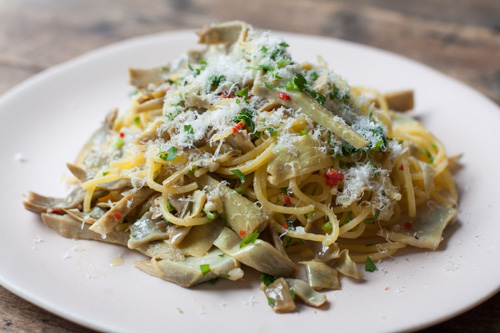Artichoke spaghetti with chilli, lemon and parsley
 Friday, March 11, 2016 at 8:53PM
Friday, March 11, 2016 at 8:53PM 
I made this pasta a few weeks back for my cooking demo at the Natoora shop in Chiswick. Everyone loved it. One man loved it so much he bought every ingredient on the recipe card so he could recreate it at home.
For such a simple pasta, it took a while to perfect. The first one was too dry, the second too lemony, the third was just right. This is the third recipe.
In the pictures, the artichokes are the mammole variety. They are similar to globe artichokes, in that they have meaty and tender outer leaves which can be eaten raw or cooked. A colleague who was watching me do my practice run for the shop asked why I had used mammole if I was only using the heart. He suggested tema or spiky artichokes instead. He is Italian so I thought I’d best not argue.
I settled on spiky in the end, but tema would be just as good. Both are beautifully tender once cooked. If you can't get hold of either, then just use the hearts of whichever variety is available.
The Italian ‘less is more’ approach makes the most of the delicate flavour of the artichokes. I sautéed them in olive oil with garlic, chilli, lemon zest and a little water. Sprinkle over a little parsley and Parmesan and you have a pasta sauce that is perfect in it’s simplicity.
Serves 2 as a main or 4 as a starter.

Ingredients
4 tema or spiky artichokes
75ml extra virgin olive oil, approx
3 cloves garlic, finely chopped
1 mild red chilli, finely chopped
Zest and juice of 1 lemon
Small bunch parsley, finely chopped
50g Parmesan, or to taste
250g fresh spaghetti
Serves 2 as a main
Method
Put the lemon juice in a large bowl. To prepare the artichokes, peel away the tough outer leaves until you reach the tender yellow/purple leaves (about halfway). Trim the stalk to 2 inches, approx. Slice the tops of the leaves off. Using a vegetable peeler or paring knife, trim any rough edges where you have torn the leaves off and the tough skin at the base of the flower and along the stalk.
Slice each artichoke in half, remove the choke and any spiky leaves in the centre with a paring knife and discard. Slice the artichoke hearts into thin pieces lengthways. Put in the bowl with the lemon juice and toss to coat; this is to stop it discolouring.
Put a large saucepan of salted water on to boil for the pasta.
Heat the olive oil in a large frying pan over a low heat. Add the garlic and fry gently for a few minutes, stirring frequently. Drain the artichokes of any excess lemon juice and add to the pan with the chilli, lemon zest and a little water. Turn the heat up to medium and sauté until tender (8-10 minutes), adding more water as required.
Cook the spaghetti for 2 minutes or until al dente, drain over a large bowl, reserving the cooking liquid, and add to the spaghetti to the pan with the artichokes. Add the parsley, half of the Parmesan and toss. Add some of the cooking liquid, as required, for moisture. You can also add more oil, if you prefer.
Serve immediately with Parmesan as a garnish.


Reader Comments (1)
This sounds delicious. I often end up putting far too much in my pasta sauces and over doing it. Less is more indeed.